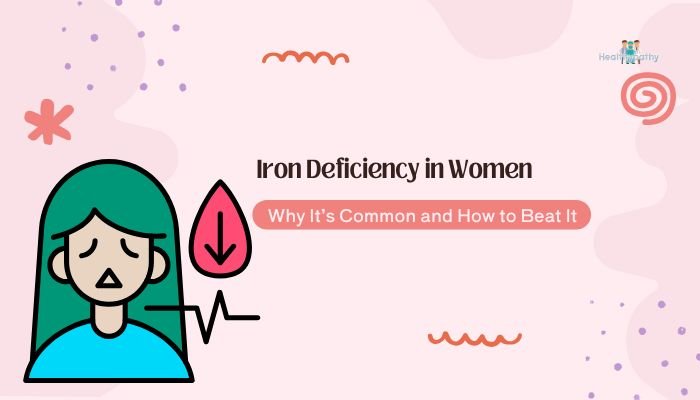Introduction
Iron deficiency is a significant nutritional concern worldwide, especially for women. From monthly blood loss in menstruation to increased demands during pregnancy, various factors contribute to this shortfall. When iron levels dip too low, you can experience symptoms like fatigue, weakness, and difficulty focusing. Understanding how iron deficiency arises—and how to restore adequate stores—can make a dramatic difference in daily energy and long-term well-being. This article explains why women commonly face iron deficits, tells you how to spot warning signs, and provides practical advice on diet, supplementation, and prevention strategies.
Why Women Are More Prone to Iron Deficiency
Menstruation
Each menstrual period draws blood—and thus iron—out of the body. While monthly loss might be moderate for some, heavy or prolonged periods can compound the effect, steadily lowering iron reserves.
Pregnancy and Childbearing
During pregnancy, iron requirements surge as the body produces extra blood for the growing fetus, placenta, and mother’s own volume. Inadequate intake or absorption, coupled with these demands, may result in iron deficiency anemia if not addressed.
Diet and Lifestyle Factors
A diet low in iron-rich foods—especially heme iron (the form most readily absorbed, found in animal products)—can exacerbate deficiency. Vegetarian or vegan diets are not necessarily lacking, but require careful planning to meet iron needs through plant-based sources and vitamin C–rich foods to boost absorption.
Spotting the Signs of Iron Deficiency
Fatigue and Weakness
Insufficient iron translates to reduced hemoglobin, limiting oxygen transport around the body. This often leads to persistent tiredness and lower stamina.
Pale Skin or Brittle Nails
Hemoglobin gives blood its red color; a dip in its levels can make skin look paler than usual and cause nails to split or break easily.
Headaches and Dizziness
The brain requires a steady oxygen supply. When iron is low, slight oxygen reduction may prompt frequent headaches, lightheadedness, or dizziness.
Unusual Cravings (Pica)
Some people with iron deficiency develop pica—cravings for non-food items like ice, clay, or starch, indicating a serious shortfall needing medical evaluation.
Diagnosing Iron Deficiency
Blood Tests
If symptoms point to low iron, healthcare providers typically run:
- Complete Blood Count (CBC): Checks hemoglobin, hematocrit, and red blood cell indices.
- Serum Ferritin: Reflects iron stores in the body (ferritin <30 ng/mL often indicates iron deficiency).
- Serum Iron and Transferrin Saturation: Offer additional detail on iron transport.
Uncovering Underlying Causes
Doctors may investigate heavy menstruation, gastrointestinal blood loss, or malabsorption issues if blood work indicates anemia. Untreated GI conditions like celiac disease can hamper iron absorption, further contributing to deficiency.
Strategies to Overcome and Prevent Iron Deficiency
Dietary Changes
Boost iron intake by focusing on:
- Lean Meats and Seafood: Heme iron sources (beef, chicken, fish) absorbed more efficiently.
- Legumes and Dark Leafy Greens: Plant-based sources like spinach, lentils, and beans.
- Iron-Fortified Grains: Cereals or breads enriched with iron.
Pair these foods with vitamin C–rich items (citrus fruits, bell peppers) to enhance iron uptake.
Supplements
If dietary adjustments aren’t sufficient:
- Oral Iron Supplements: Ferrous sulfate, ferrous gluconate, or chelated iron forms. Usually taken on an empty stomach for best absorption, though GI side effects can occur.
- IV Iron Therapy: For severe deficiency or malabsorption issues. Typically administered under close medical supervision.
Menstrual Blood Loss Management
Women with notably heavy periods (menorrhagia) may find relief through:
- Hormonal Contraceptives: Birth control pills or IUDs can regulate or reduce bleeding.
- Non-Hormonal Options (Tranexamic Acid): Slows menstrual bleeding effectively, often recommended for brief use each cycle.
- Surgical Procedures: For extreme menorrhagia, interventions like endometrial ablation or myomectomy may be considered, especially if fibroids or polyps are involved.
Lifestyle and Self-Care
Hydration and Balanced Eating
Dehydration can worsen fatigue, while stable blood sugar levels and balanced macronutrient intake bolster energy. Focus on lean proteins, complex carbs, and healthy fats in synergy with iron-rich foods.
Monitoring Progress
Regular check-ups help assess whether iron levels are improving. Rechecking hemoglobin and ferritin at intervals ensures you’re on track and can address shortfalls early.
Watch for Overdosing on Iron
While addressing deficiency is important, excessive iron can harm organs. Always follow healthcare instructions on dosage and avoid self-prescribing large amounts of supplements.
Conclusion
Iron deficiency remains a common issue among women, exacerbated by menstruation, pregnancy demands, and dietary habits. Feeling chronically tired or noticing changes in skin or nails may signal the need for testing. By fortifying your diet with iron-rich foods, leveraging supplements when necessary, and working with a provider to manage heavy periods, you can replenish your iron stores and maintain better overall health. Ultimately, consistent monitoring and proactive choices lead to a sustained improvement in energy levels, helping you thrive day-to-day.
References
- World Health Organization (WHO). Nutritional anaemias: tools for effective prevention and control. 2021.
- Centers for Disease Control and Prevention (CDC). Iron deficiency in women: data and prevention strategies. 2020.
- National Institutes of Health (NIH). Office of Dietary Supplements: Iron Fact Sheet for Health Professionals. 2021.
- American Society of Hematology (ASH). Understanding anemia in women. 2019.
- American College of Obstetricians and Gynecologists (ACOG). Heavy menstrual bleeding and its management. 2022.







